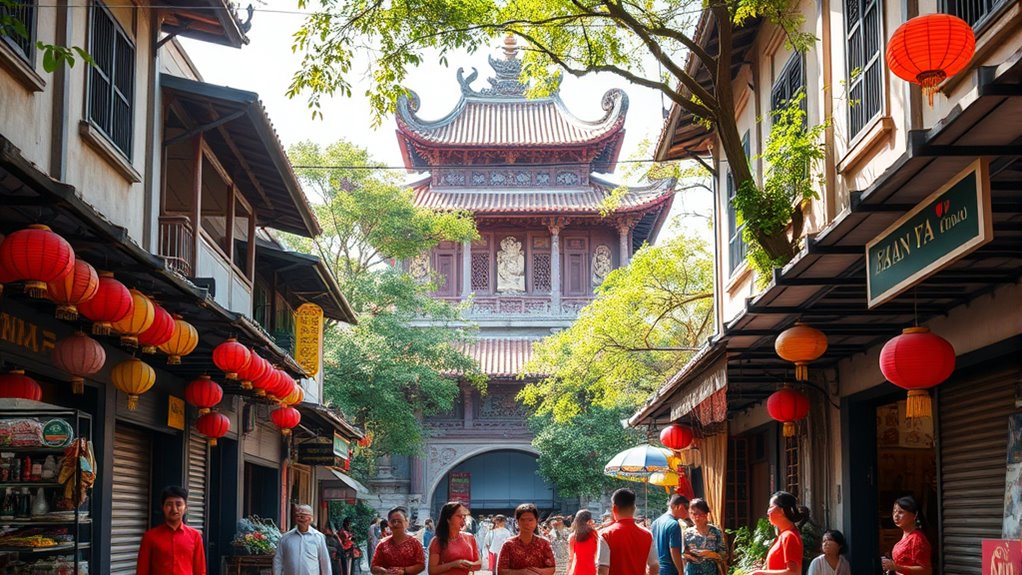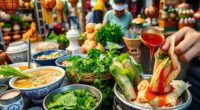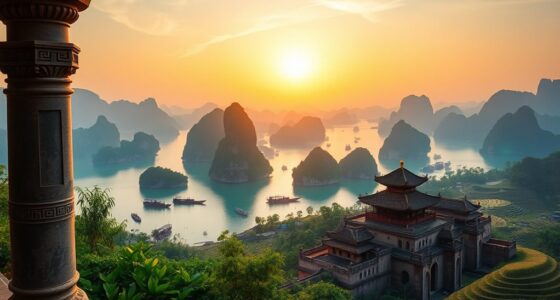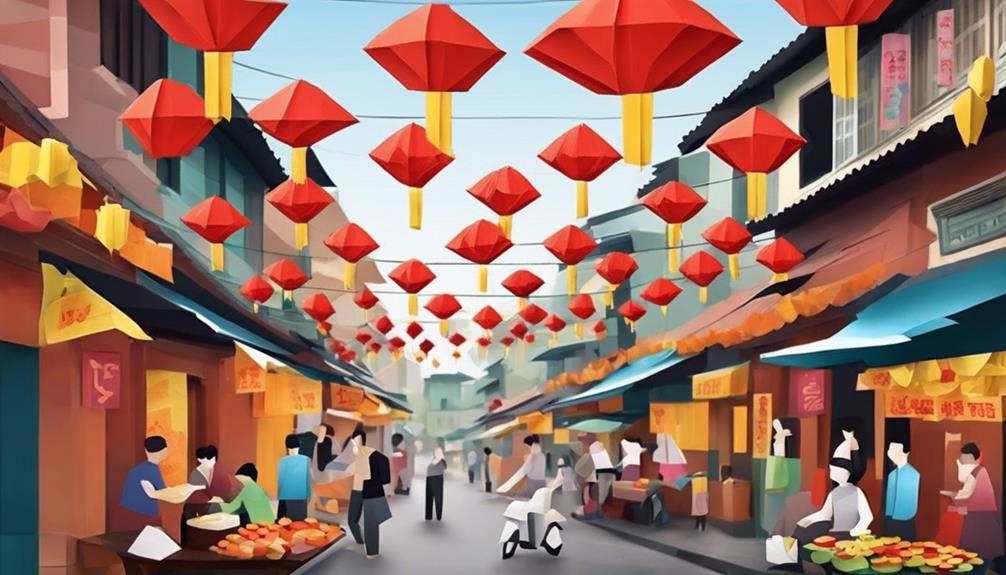Vietnam’s history spans over 2,800 years of resilient dynasties, colonial struggles, and war, shaping a rich cultural heritage. From ancient times with powerful kingdoms like the Hong Bang Dynasty, to resisting Chinese domination and forging independence, Vietnam’s culture is vibrant with folk arts, festivals, and unique crafts. Modern history includes colonial rule, reunification, and economic reforms. To explore how these elements intertwine and define Vietnam today, keep exploring how its past influences its lively traditions and national identity.
Key Takeaways
- Vietnam’s history spans from the Hong Bang Dynasty through centuries of resistance against Chinese domination, culminating in independence in 938 CE.
- Cultural expressions include folk arts, crafts, festivals, and rituals that reflect regional identities, spiritual beliefs, and historical narratives.
- Key historical periods, such as French colonization, the Vietnam War, and Đổi Mới reforms, have shaped Vietnam’s social, political, and economic development.
- Traditional arts, cuisine, and festivals like Tet and Mid-Autumn Festival reinforce community bonds and preserve cultural heritage.
- Vietnam’s cultural identity is a blend of indigenous traditions, external influences, and modern adaptations, emphasizing resilience and continuity.
Origins and Early Foundations of Vietnamese Civilization

Have you ever wondered how Vietnam’s rich civilization began? It all starts with the legendary Hong Bang Dynasty, which dates back to around 2879 BCE. This era marks the unification of tribes, laying the foundation for Vietnamese society. Over the centuries, Vietnam resisted more than a thousand years of Chinese domination, finally gaining independence in 938 CE after Ngô Quyền’s victory at Bạch Đằng. Early dynasties like Đinh, Lê, and Lý centralized power and established administrative systems that shaped the Vietnamese state. During this period, rice agriculture flourished, supported by irrigation projects like the Red River dike. These early foundations fostered a distinct cultural identity rooted in resilience, agricultural innovation, and tribal unification, setting the stage for Vietnam’s enduring civilization. Promoting biodiversity in agricultural practices can enhance sustainability and resilience for future generations.
Dynastic Evolution and Cultural Flourishing
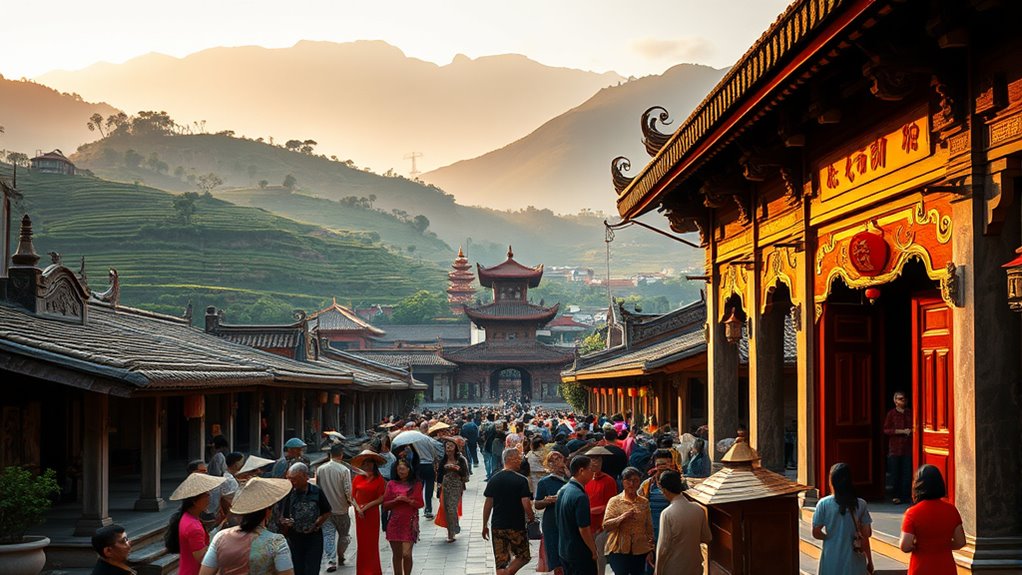
Following the early foundations of Vietnamese civilization, the dynastic evolution brought about significant cultural and political developments. During this period, you see the rise of powerful dynasties that shaped Vietnam’s identity. Architectural styles from these eras reflected both imperial authority and local traditions, leaving a lasting legacy. 1. The Later Lê dynasty flourished with Confucian bureaucracy and vibrant literature, emphasizing education and moral values. 2. The Nguyen dynasty built the Imperial City in Huế, solidifying Confucian ideals and integrating Buddhism and indigenous beliefs into everyday life. 3. Cultural expressions like folk arts, water puppetry, and traditional music thrived, reflecting a rich blend of indigenous and external influences. These dynasties fostered a sense of national identity, advancing arts, governance, and societal values that continue to influence Vietnam today.
Colonial Period and the Path to Independence

Why did Vietnam’s fight for independence become such a defining chapter in its history? Because it shaped the nation’s identity and resilience. When the French colonized Vietnam in the mid-19th century, they imposed Western political systems and exploited local resources. You would have seen Vietnamese resistance rise, from small uprisings to organized movements. The development of a nationalist and communist consciousness, led by figures like Ho Chi Minh, fueled the fight for sovereignty. The August 1945 uprising, after years of struggle, finally ended French rule. This victory marked a turning point, inspiring future generations to defend their independence fiercely. The colonial period exposed Vietnam’s determination to regain its freedom, forging a unifying narrative rooted in resistance and national pride.
The Vietnam War and Its Lasting Effects

The Vietnam War dramatically reshaped the country’s political, social, and economic landscape, leaving deep scars that still influence Vietnam today. You might notice ongoing debates about war legacy, veteran support, and national unity. The conflict caused immense loss of life, destruction, and political upheaval, which shaped Vietnam’s modern identity.
The Vietnam War’s legacy continues to shape Vietnam’s identity and ongoing national debates.
Here are three key lasting effects:
- Political division – The war solidified communist control and created a divided society, influencing governance.
- Social trauma – Generations grapple with war memories, trauma, and the impacts of agent orange.
- Economic challenges – Post-war devastation slowed growth until reforms like Đổi Mới in 1986 spurred recovery.
These effects continue to influence Vietnam’s development and national consciousness.
Post-War Reconciliation and Economic Transformation
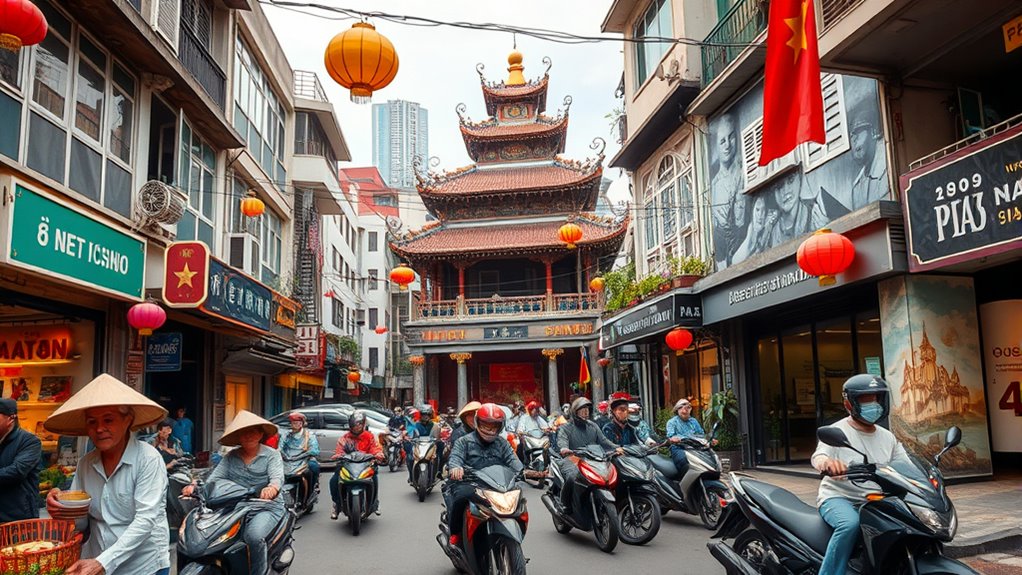
After the Vietnam War ended in 1975, you face the challenge of healing divided communities and rebuilding the shattered economy. The reunification brought hope, but also hardship as the country struggled to recover from war damage. In the late 1980s, Vietnam introduced Đổi Mới reforms, shifting toward a socialist-oriented market economy. These reforms encouraged private enterprise, attracted foreign investment, and modernized agriculture and industry. You see rapid growth, urbanization, and increased exports, helping lift millions out of poverty. At the same time, efforts to reconcile communities focus on promoting national unity and preserving cultural traditions. You witness a balance between modernization and cultural heritage, as Vietnam steadily moves toward a more integrated, resilient society. The journey continues, driven by resilience and a shared desire for progress. Environmental considerations and sustainable practices play a vital role in ensuring that development benefits future generations.
Core Elements of Vietnamese Cultural Identity
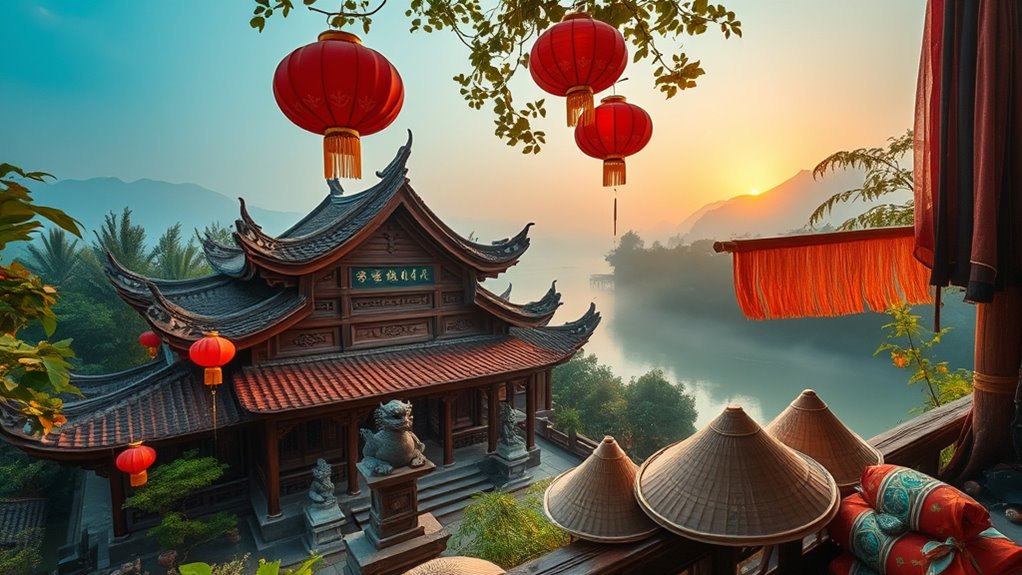
You can see that family and social hierarchy play a vital role in shaping Vietnamese identity, emphasizing respect and filial piety. Folk arts and traditions, like water puppetry and silk painting, reflect centuries of cultural expression and community values. Additionally, international influences have contributed to the evolution of Vietnamese cultural practices, blending indigenous traditions with global elements. Together, these elements highlight how history and customs continue to define what it means to be Vietnamese today.
Family and Social Hierarchy
Family and social hierarchy form the backbone of Vietnamese cultural identity, shaping daily life and social interactions. Rooted in Confucian principles, these structures emphasize respect for elders, filial piety, and clear ranks within families and society. You are expected to honor your parents and elders, maintaining harmony and order. Respect is shown through language, gestures, and obedience, reinforcing social stability. Hierarchies influence decision-making, family roles, and community relationships, ensuring tradition persists across generations. An understanding of social hierarchy is essential to fully grasp the intricacies of Vietnamese cultural values.
Folk Arts and Traditions
Folk arts and traditions are essential expressions of Vietnam’s rich cultural identity, reflecting centuries of history, spirituality, and community life. You can explore vibrant water puppetry, intricate silk paintings, and lively folk music that have been passed down through generations. These arts celebrate local stories, beliefs, and daily life, connecting communities and preserving heritage. Whether participating in festivals or watching performances, you’ll experience the deep roots of Vietnamese creativity. Here’s a glimpse of some popular folk arts:
| Art Form | Description | Significance |
|---|---|---|
| Water Puppetry | Wooden puppets performed on water | Celebrates rural life |
| Folk Music | Songs using traditional instruments | Expresses communal stories |
| Silk Painting | Hand-painted silk artworks | Showcases craftsmanship |
| Lunar Festivals | Celebrations blending traditions | Honoring ancestors |
| Handicrafts | Embroidery, pottery, weaving | Preserves local skills |
A deep cultural tradition continues to influence modern Vietnamese arts and celebrations.
Traditional Arts, Cuisine, and Festivals
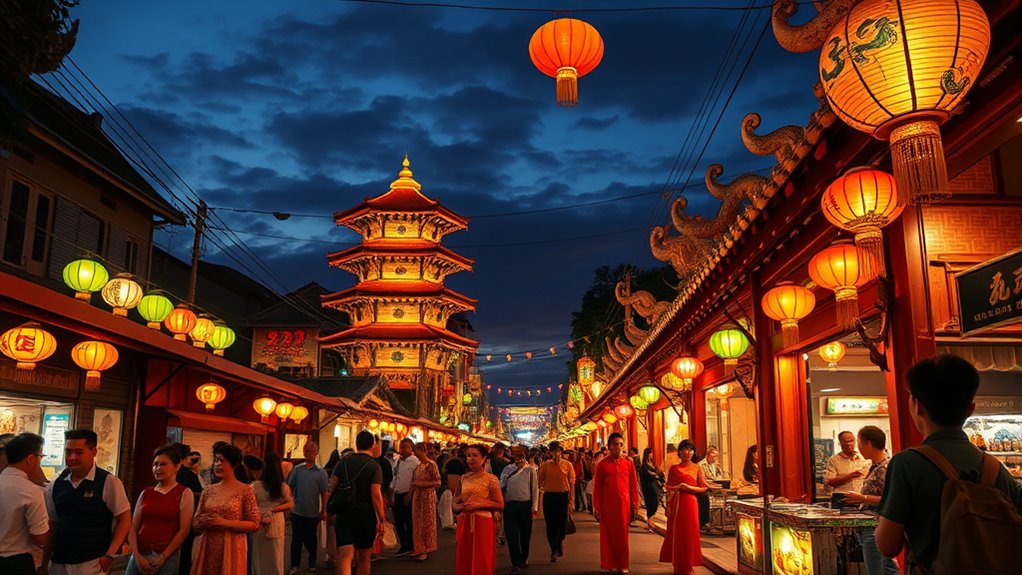
You can experience Vietnam’s rich cultural tapestry through its folk arts and crafts, which showcase centuries of tradition in everything from silk painting to water puppetry. The country’s diverse regions boast unique culinary flavors, blending indigenous ingredients and external influences into dishes like pho and banh mi. Festivals and rituals, often rooted in Buddhist, Confucian, and indigenous practices, celebrate ancestors and lunar cycles with vibrant ceremonies and cultural performances. Exploring traditional arts provides a deeper appreciation for the country’s heritage and creative expressions.
Folk Arts and Crafts
Traditional arts, cuisine, and festivals form the vibrant heart of Vietnam’s cultural identity, reflecting centuries of history and regional diversity. As you explore folk arts and crafts, you’ll find a rich tradition of craftsmanship and artistic expression. These crafts showcase local materials and techniques passed down through generations, embodying regional stories and beliefs. You might encounter delicate silk paintings, intricate wood carvings, or vibrant ceramics. These crafts often serve spiritual, functional, and decorative purposes, connecting communities to their ancestors and environment. Engaging with these arts allows you to appreciate Vietnam’s deep cultural roots and the creativity that persists today. Exploring the educational value of these traditional crafts can also enhance understanding of Vietnam’s history and cultural significance.
Regional Culinary Flavors
Have you ever wondered how Vietnam’s diverse regions craft unique flavors that reflect their history and environment? In the North, you’ll find dishes like pho, with rich broth and fresh herbs, influenced by ancient Chinese and indigenous traditions. Central Vietnam offers spicy, bold flavors in dishes like bun thit nuong, using chili peppers, lemongrass, and seafood, reflecting its coastal heritage. The South features sweeter, milder tastes with dishes like hu tieu and fresh spring rolls, shaped by tropical fruits and colonial influences. Each region’s cuisine incorporates local ingredients such as rice, fish, and herbs, blending indigenous techniques with external influences over centuries. These flavors tell stories of trade, war, and cultural exchange, creating a culinary mosaic that’s as rich and varied as Vietnam’s history itself. Regional culinary diversity illustrates how geography and history shape traditional dishes across Vietnam.
Festival Traditions and Rituals
Festival traditions and rituals form a vibrant thread in Vietnam’s cultural fabric, bringing communities together to celebrate history, spirituality, and shared identity. You’ll experience colorful celebrations that honor ancestors, deities, and seasonal changes. These festivals often feature lively processions, traditional music, and dance, reflecting Vietnam’s rich cultural heritage. During Tet, the Lunar New Year, families pay homage to ancestors with offerings and cleaning rituals. The Mid-Autumn Festival involves lantern displays and mooncake sharing, symbolizing unity and prosperity. Additionally, the Perfume Pagoda Festival attracts pilgrims seeking spiritual blessings. Here’s a quick overview:
- Ancestral Worship Ceremonies
- Lantern and Dragon Dances
- Seasonal Agricultural Festivals
To enhance the cultural experience, many festivals incorporate traditional arts like dance and music, which play a vital role in preserving Vietnam’s cultural legacy.
Frequently Asked Questions
How Did Vietnamese Language Evolve Over Different Historical Periods?
Vietnamese language evolved through various influences and reforms over time. You’ll notice it began with Classical Chinese used in administration and literature, then incorporated indigenous words. During French colonization, the Latin-based “Quoc ngu” script was developed, making literacy more accessible. Today, you see a blend of traditional vocabulary and modern terms, reflecting Vietnam’s history, cultural exchanges, and efforts to preserve its linguistic identity amidst ongoing social changes.
What Are the Most Significant Symbols of Vietnamese National Identity?
You should recognize that the most significant symbols of Vietnamese national identity include the red flag with a yellow star, representing unity and socialism. Additionally, the iconic conical hat (nón lá) symbolizes traditional craftsmanship and rural life. The dragon, a mythological creature, embodies strength and energy. Finally, the lotus flower signifies purity and enlightenment, deeply rooted in cultural and spiritual values, making these symbols powerful representations of Vietnam’s identity.
How Do Traditional Festivals Reflect Vietnam’s Historical Influences?
Traditional festivals in Vietnam are like history’s greatest hits, showing off influences from Buddhism, Confucianism, and indigenous beliefs. You’ll see ancestor worship, lunar calendar celebrations, and vibrant rituals that honor past rulers and spiritual practices. These festivals celebrate resilience and cultural pride, proving that Vietnamese history isn’t just chapters in a book — it’s a lively, colorful party that keeps the nation’s soul alive and kicking.
What Role Did Indigenous Beliefs Play Alongside Buddhism and Confucianism?
Indigenous beliefs play a essential role in Vietnam’s spiritual landscape, coexisting with Buddhism and Confucianism. You see this in festivals that honor nature spirits, ancestors, and local deities, blending animist practices with these major religions. These beliefs influence daily life, rituals, and community celebrations, emphasizing harmony with nature and respect for ancestors. They create a unique spiritual identity that enriches Vietnam’s cultural fabric and traditions.
How Has Vietnamese Architecture Been Influenced by Historical Events?
Vietnamese architecture is like a tapestry woven through history, reflecting each era’s influences. You’ll notice that Chinese, French, and indigenous styles blend seamlessly in structures like pagodas, colonial buildings, and imperial palaces. These influences came through conquests, colonization, and cultural exchanges, shaping a unique architectural identity. As a result, Vietnam’s buildings tell stories of resilience and adaptation, standing as symbols of its dynamic history and evolving cultural landscape.
Conclusion
As you explore Vietnam’s rich history and vibrant culture, you discover its resilience, its innovation, and its enduring spirit. You see a nation shaped by ancient traditions and modern aspirations, a people proud of their past and hopeful for their future. You witness the harmony of history and progress, of heritage and innovation, of struggle and triumph. In embracing Vietnam’s story, you connect with a culture that continues to thrive, flourish, and inspire.

